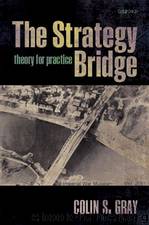The Strategy Bridge: Theory for Practice by Colin S. Gray

Author:Colin S. Gray
Language: eng
Format: epub
Published: 2015-09-27T04:00:00+00:00
And Yet, Purposeful Strategy is Possible
The strategist's mission is fraught with peril. Whether or not he is accomplished, pathologies, maladies, disharmonies, cunning enemies, and sheer bad luck lurk to ambush him. Moreover, the strategist's contexts for thought and action fundamentally cannot be evaded. He may select one strategic path over another, he may shift paths, effect the strategic equivalent to a ‘Hohmann transfer’ move from one strategic orbital path to another, and he may even perform utterly innocent of any centralized purposeful strategy whatsoever, but he cannot avoid behaving to strategic effect.66 Conflict behaviour has strategic consequences, which is to say effect, whether or not the effect achieved was intended. Restated in basic functional terms, it is accurate to claim that strategy is unavoidable.
This chapter has not sought to spare the reader exposure to the hazards for strategy and strategists, though there has been no endeavour to present the dangers encyclopaedically. By way of the tersest of summaries, this discussion pointed to, and analysed, eight clusters of problems for strategy. These were: (a) lack of understanding of the strategic function; (b) enemy behaviour; (c) the challenge of currency conversion of threat and military (and other) action into desirable strategic, and then political, consequences; (d) the shortage of strategic expertise and the poverty of the strategy‐making process; (e) a complex product of culture, personality, biology, psychology, circumstance, and poor human performance; (f) the complexity and disharmony among all the levels of behaviour that comprise strategy's domain; (g) the realities of friction in the uniquely stressful climate of war, and the inherent impossibility of reliable prediction; and (h) the culture (inter alia) clash integral to the very nature of the civil–military relationship that must develop strategy and perform strategically.
So much for the bad news. But if the strategist is so variously and seriously harassed, how can he ever succeed? In a justly celebrated analysis, Richard K. Betts posed the question directly, ‘Is Strategy an Illusion?’67 He answered convincingly that it is not. Furthermore, there is no doubt that Clausewitz would have agreed (p.155)with Betts' argument, notwithstanding his major contribution to registration of the perils that impede strategic performance. Since the strategic function is literally inescapable, even though explicit purposeful strategy is not, it is fortunate that somehow, seemingly against mighty odds, the strategist can succeed. How can this be so?
There appear to be four broad and mercifully potent reasons why purposeful strategy is feasible. First, the greatest of all problems for the strategist is also the reason why the strategic function can be performed successfully. This glorious paradox lies in the fact that the enemy too is beset by potentially unsolvable problems, by far the most significant among which should be us, his enemy. Thus, both calamity and salvation lie in the adversarial nature, not merely character, of strategy and the strategic function performed sometimes by people explicitly charged to develop and execute strategies. There is something deeply satisfying, certainly reassuring, about this paradox.
The second source of relief for the strategist lies
Download
This site does not store any files on its server. We only index and link to content provided by other sites. Please contact the content providers to delete copyright contents if any and email us, we'll remove relevant links or contents immediately.
| Anthropology | Archaeology |
| Philosophy | Politics & Government |
| Social Sciences | Sociology |
| Women's Studies |
The Secret History by Donna Tartt(18139)
The Social Justice Warrior Handbook by Lisa De Pasquale(11949)
Thirteen Reasons Why by Jay Asher(8436)
This Is How You Lose Her by Junot Diaz(6428)
Weapons of Math Destruction by Cathy O'Neil(5819)
Zero to One by Peter Thiel(5480)
Beartown by Fredrik Backman(5341)
The Myth of the Strong Leader by Archie Brown(5234)
The Fire Next Time by James Baldwin(5013)
How Democracies Die by Steven Levitsky & Daniel Ziblatt(4950)
Promise Me, Dad by Joe Biden(4907)
Stone's Rules by Roger Stone(4849)
100 Deadly Skills by Clint Emerson(4683)
A Higher Loyalty: Truth, Lies, and Leadership by James Comey(4545)
Rise and Kill First by Ronen Bergman(4542)
Secrecy World by Jake Bernstein(4383)
The David Icke Guide to the Global Conspiracy (and how to end it) by David Icke(4376)
The Farm by Tom Rob Smith(4320)
The Doomsday Machine by Daniel Ellsberg(4240)
